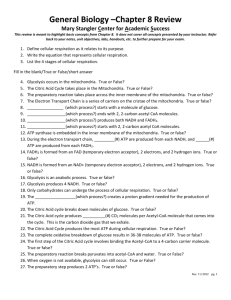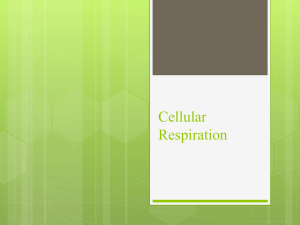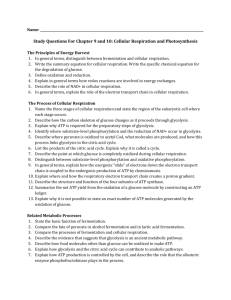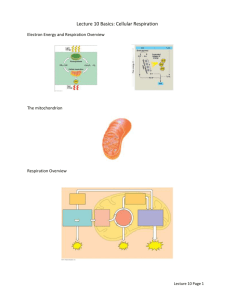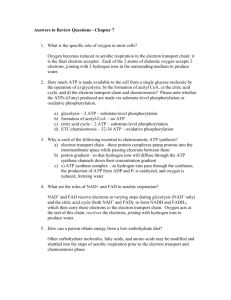5. How Cells Harvest Energy
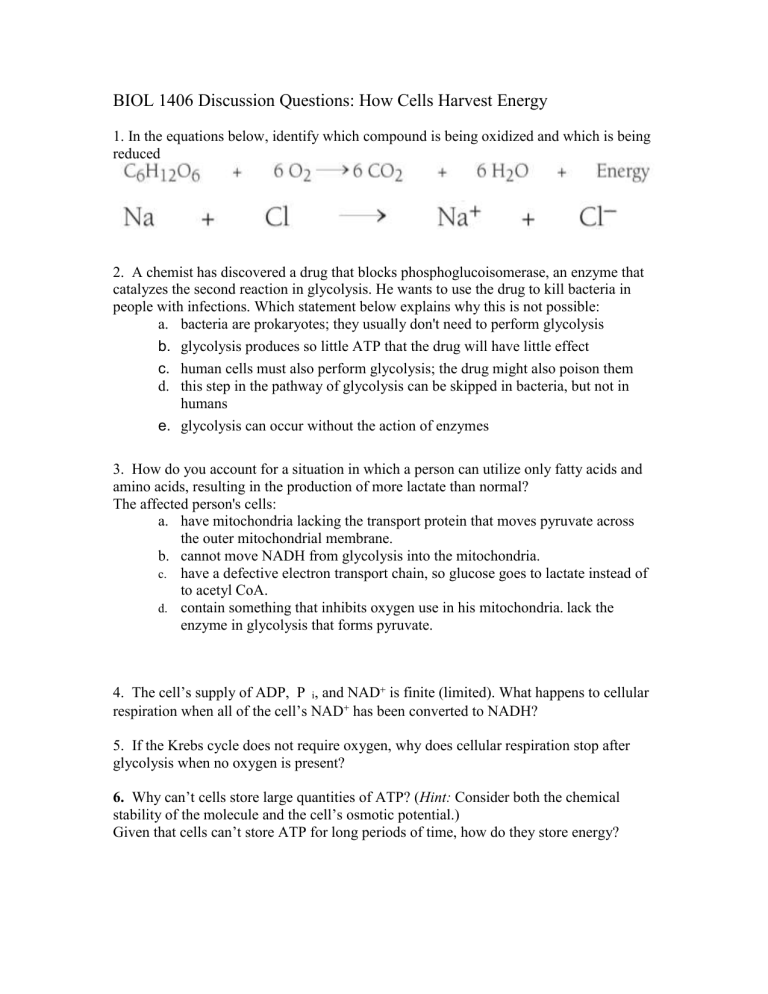
BIOL 1406 Discussion Questions: How Cells Harvest Energy
1. In the equations below, identify which compound is being oxidized and which is being reduced
2. A chemist has discovered a drug that blocks phosphoglucoisomerase, an enzyme that catalyzes the second reaction in glycolysis. He wants to use the drug to kill bacteria in people with infections. Which statement below explains why this is not possible: a.
bacteria are prokaryotes; they usually don't need to perform glycolysis b.
glycolysis produces so little ATP that the drug will have little effect c.
human cells must also perform glycolysis; the drug might also poison them d.
this step in the pathway of glycolysis can be skipped in bacteria, but not in humans e.
glycolysis can occur without the action of enzymes
3. How do you account for a situation in which a person can utilize only fatty acids and amino acids, resulting in the production of more lactate than normal?
The affected person's cells: a.
have mitochondria lacking the transport protein that moves pyruvate across the outer mitochondrial membrane. b.
cannot move NADH from glycolysis into the mitochondria. c.
have a defective electron transport chain, so glucose goes to lactate instead of d.
to acetyl CoA.
contain something that inhibits oxygen use in his mitochondria.
lack the enzyme in glycolysis that forms pyruvate.
4. The cell’s supply of ADP, P
i
, and NAD respiration when all of the cell’s NAD
is finite (limited). What happens to cellular
has been converted to NADH?
5. If the Krebs cycle does not require oxygen, why does cellular respiration stop after glycolysis when no oxygen is present?
6. Why can’t cells store large quantities of ATP? ( Hint: Consider both the chemical stability of the molecule and the cell’s osmotic potential.)
Given that cells can’t store ATP for long periods of time, how do they store energy?
7. A new species has been discovered and it was found that they possessed some mitochondria with unfolded cristae. What generalizations can you make about this organisms metabolism?
8. Sports physiologists at an Olympic training center wanted to monitor athletes to determine at what point their muscles were functioning anaerobically. Explain why this would be important to the athletes. Design an experiment that would provide the data wanted by the physiologist.
9. How can we justify using the disappearance of oxygen from the solution as a measure of electron transport?
10. To diagnose a bird’s nutritional state, biologists feel the breast muscle. If the muscle mass is reduced enough that the sternum (breastbone) sticks out, biologists conclude the individual is near starvation. The logic here is that the individual is using muscle proteins as an energy source because all of its fat and carbohydrate stores have been used up. Why would proteins be the last source of stored chemical energy to be used by an organism?
11. In an experiment, mice were fed glucose (C
6
H
12
O
6
) containing a small amount of radioactive oxygen. The mice were closely monitored, and in a few minutes radioactive oxygen atoms showed up in which compound?
12.
Understanding THE BIG PICTURE a.
Where is each of the reactants used in the overall process? b.
Where do the reactants come from? c.
Where is each of the products produced in the overall process? d.
What is the fate if each of the products?
C
6
H
12
O
6
6 O
2
6 CO
2
6 H
2
O
Energy a. What is/are the overall function(s) of glycolysis? b. What is/are the overall function(s) of the Krebs cycle?
. c. What is/are the overall function(s) of oxidative phosphorylation?
Are the compounds listed here used or produced in:
Glucose
O
2
CO
2
H
2
O
ATP
ADP
P
i
Glycolysis? The Krebs cycle? Oxidative phosphorylation?
NADH
NAD
.
13. To make a 5 M solution of hydrochloric acid, we add 400 ml of 12.5 M hydrochloric acid to 600 ml of distilled water. Before we add the acid, however, we place the flask containing the distilled water into the sink because this solution can heat up so rapidly that the flask breaks. How is this reaction similar to what happens in chemiosmosis? How is it different?
14. Hummingbirds and nectar-feeding insects eat a diet that is rich in sugars and extremely low in protein. How are these individuals able to synthesize the amino acids and proteins they require for growth?
15. A cell is moved from an aerobic to anaerobic environment where the only food source is glucose. Is it possible for this cell to maintain its original ATP synthesis rate? Explain
16. Is it possible for your muscle cells to live if they are deprived of oxygen? Deprived of
ATP? Use your knowledge of cellular respiration regulation to explain how the body would respond and potential consequences
17. DNP (dinitropheonol) was one of the first drugs prescribed by physicians in the 1940s to in weight loss. It was quickly pulled from the market after several deaths. Explain how
DNP aided in weight loss. (You may need to do some research outside of the text)
18. Predict the consequences of a drug that disrupts the pH balance across the mitochondrial membrane of the electron transport train
19. The following 2 equations are examples of combustion reactions. ethanol + oxygen----> CO2 + H2O + energy glucose + oxygen----> CO2 + H2O + energy
How are these 2 reactions similar?
20. In the presence of a metabolic poison that specifically and completely inhibit the function of mitochondrial ATP synthase, how would you expect the pH difference to change across the inner mitochondrial membrane? What would be the ultimate fate of
ATP production?
21.In the 1940s, some physicians prescribed low doses of a drug called dinitrophenol
(DNP) to help patients lose weight. This unsafe method was abandoned after a few patients died. DNP uncouples the chemiosmotic machinery by making the lipid bilayer of the inner mitochondrial membrane leaky to H+. What impact does this have on ATP production? Be sure to address substrate and oxidative level phosphorylation
22. Glucose, made from six radioactively labeled carbon atoms, is fed to yeast cells in the absence of oxygen. How many molecules of radioactive alcohol (C2H5OH) are formed from each molecule of glucose?
23. Cyanide is a poison that blocks the passage of electrons along the electron transport chain. Predict the metabolic effect of this poison? Include pH, NADH, proton gradient and electrons in your answer.
24. You have a friend who lost 15 pounds of fat on a diet. Where did the fat go (how was it lost)?
25. Using the terms below:
Option 1: Create a concept map using http://ctools.msu.edu/ctools/index.html
Option 2: Create a working model using materials provided glycolysis cytoplasm electrons protons glucose
NAD
NADH
Be prepared to share with class
ADP
P
i
ATP pyruvate ethyl alcohol (or lactic acid) substrate-level phosphorylation
26. Using the terms below:
Option 1: Create a concept map using http://ctools.msu.edu/ctools/index.html
Option 2: Create a working model using materials provided glucose oxygen carbon dioxide pyruvate acetyl CoA
NAD
NADH
FAD
FADH
2
Be prepared to share with class
ADP
P
i
ATP water electron transport chain mitochondria inner mitochondrial membrane outer mitochondrial membrane
H
electrons ( e
) chemiosmosis
ATP synthase (proton pumps) cristae proton gradients oxidative phosphorylation substrate-level phosphorylation oxidative phosphorylation
27. Research what is meant by “oxygen debt”. a.
b.
c.
d.
e.
f.
g.
What is oxygen debt?
Would lactic acid fermentation be more useful to a sprinter or a long distance runner? Why?
In active muscle tissue, when the supply of oxygen is not adequate for the demands of oxidative phosphorylation, what happens?
Why is that important? (Hint: Especially for wild animals).
Why does deep breathing continue even after strenous exercise (e.g. running) has stopped?
What does it mean when a runner "hits the wall"?
Why do we not eat only glucose?
Case Study
Adapted from http://www.lifescied.org/cgi/reprint/3/1/62.pdf
About the case: The case study we present is based on an actual case of rotenone poisoning of a young girl (De Wilde, 1986). Rotenone is a naturally occurring chemical derived from the roots of several tropical and subtropical plants.
It inhibits chemiosmosis by interfering with NADH dehydrogenase preventing utilization of NADH as a proton and electron donor in the electron transport chain (WHO; Extoxnet Pesticide Information
Notebook Rotenone, 1996; Rotenone Health and Safety Guide, Number 73).
OBJECTIVES OF THE LESSON
1.
Describe the purpose and process of cellular respiration including reactants, products, and cellular location of reactions
2.
Explain how ATP molecules are produced by the electron transport chain
3.
Describe why oxygen is important in the process of cellular respiration
4.
Analyze a case study and solve problems based on scientific data
Pre case assignment:
Create a concept map/diagram/model indicating how the following words are related:
ATP, ADP, glycolysis, Krebs cycle, the electron transport chain, electron carriers, location of glycolysis, the Krebs cycle, and the electron transport chain, and how many
ATP, NADH, and FADH
2
are manufactured from a single glucose molecule by glycolysis, the Krebs cycle, and the electron transport chain.
I. PART ONE
The Case:
You're working at the medical examiner's office at San Francisco County Hospital. It has been a particularly light day, with only 1 homicide and a dead chipmunk that you checked over for rabies. The chipmunk didn't have rabies, and you're ready to go home. Just as you're flipping the switch, you get a call from your secretary. "Francesca," he says.
"We've got a dead kid up here that you'll want to look at right away. Might be foul play."
Thinking of your four-year old daughter waiting for you at home, you grimace. "OK Jon,
I'm heading to the morgue." Performing autopsies on kids is the least favorite part of your job. But you are paid to solve medical mysteries, and it looks like you've got one here.
In the morgue, you find the report from the hospital. Glancing over it, you notice a narrative of the girl's last hours and read it carefully:
At 10 AM, mother returns from the store to find girl vomiting, not feeling well, and sleepy. Mother put girl to bed. Ten minutes later, she noticed that the child's breathing became irregular and slow. She tried to wake her daughter but was not able to do so. The child became comatose. At noon, the girl was admitted to the hospital, with no heartbeat or spontaneous breathing.
A police report states the following:
The parents discovered that the girl had been giving her dog a bath using a flea dip called
Fleacide. According to the label on the container, Fleacide is an insecticide made of plant material only and appropriate for external use on animals.
Fleaside
New and Improved
All Natural
Part One Assignment: Answer Questions
1.
What could have been in the flea dip that killed the girl?
2.
How could a product that is normally harmless to humans and pets have killed the girl?
II. PART TWO
You receive the following autopsy report
Autopsy Report:
The girl died within two hours of first vomiting
Immediate cause of death was hypoxia (lack of oxygen)
Tissue sections from the kidneys, lungs, thymus, and heart show massive cell death
Staining with cellular dyes indicates that the mitochondria within the affected tissues were damaged
Given the autopsy report, and recalling your knowledge from your reading about the functions of cellular organelles, what functions of the cell did the Fleacide affect?
A more detailed analysis of the cells from the girl's heart showed that ATP levels were reduced in the mitochondria. ATP levels in the cytoplasm of these cells, however, were normal.
In addition, acetyl-CoenzymeA levels were normal.
Part two Assignment
3.
What cellular process (or processes) was impaired by the Fleacide?
4.
Add to your concept map/model/diagram to indicate where Fleacide is acting. Be sure to highlight
III. PART THREE
Using a new chromatographic technology developed late last year, you are able to determine the levels of various subcellular components in the heart cells. Key highlights of the report are listed below:
Metabolite Autopsy Finding Normal Levels
Glucose
Pyruvate
NAD
+
NADH
102 µmol
23 µmol
6 µmol
383 µmol
100 µmol
25 µmol
75 µmol
50 µmol
Part three Assignment
5.
Given this new information, what specific cellular process do you think was affected by the Fleacide? Why?
6.
Some health food stores sell supplements containing NAD+. If you administered the supplement to the girl, could you save her? Why or why not?
7.
Would artificial respiration or oxygenation save the girl?
Why or why not?
IV.PART FOUR: A NEW CASE
Harry was very thirsty and accidently drank a poison named DCCD. Now he is feeling exhausted and tired. He decides to lie down.
The facts:
O2 is present
Harry is producing 4 ATP molecules per glucose molecule
Pyruvate if present in the cytosol and actyl CoA if present in the mitochondria
NADH is at normal levels
Part Four Assignment:
8.
Given the evidence, propose how DCCD works. Be sure to explain using a cellular respiration model. Recommend treatment


